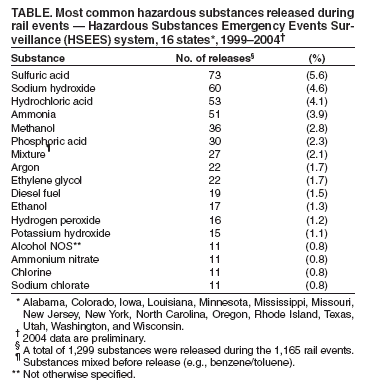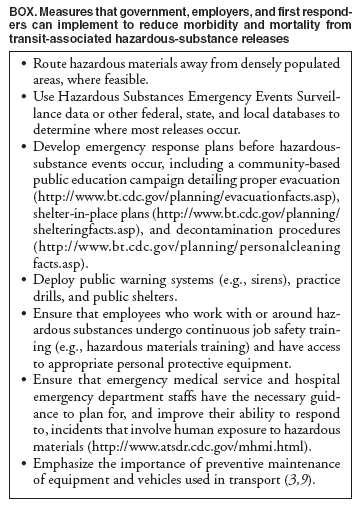 |
|
|
|
|
|
|
| ||||||||||
|
|
|
|
|
|
|
||||
| ||||||||||
|
|
|
|
|
Persons using assistive technology might not be able to fully access information in this file. For assistance, please send e-mail to: mmwrq@cdc.gov. Type 508 Accommodation and the title of the report in the subject line of e-mail. Public Health Consequences from Hazardous Substances Acutely Released During Rail Transit --- South Carolina, 2005; Selected States, 1999--2004On January 6, 2005, two freight trains collided in Graniteville, South Carolina (approximately 10 miles northeast of Augusta, Georgia), releasing an estimated 11,500 gallons of chlorine gas, which caused nine deaths and sent at least 529 persons seeking medical treatment for possible chlorine exposure (1,2; South Carolina Department of Health and Environmental Control [SCDHEC], unpublished data, 2005). The incident prompted the Agency for Toxic Substances and Disease Registry (ATSDR) to review data from its Hazardous Substances Emergency Events Surveillance (HSEES) system and update an analysis of 1993--1998 railroad events (3). The HSEES system is used to collect and analyze data concerning the public health consequences (e.g., morbidity, mortality, and evacuations) associated with hazardous-substance--release events* that occur in facilities or during transportation. This report describes the event in South Carolina, which is not part of the HSEES system, and two others from HSEES, and summarizes all rail events reported to HSEES from 16 state health departments† during 1999--2004§. Local government agencies, employers, and first responders can help reduce morbidity and mortality from transit-associated hazardous-substance releases by examining historical spill data for planning purposes, developing emergency response plans, undergoing proper hazardous materials (HazMat) training, and reviewing epidemiologic investigation data. Case ReportsSouth Carolina. At approximately 2:40 a.m. on January 6, in Graniteville, South Carolina, a freight train with three chlorine tanker cars and one sodium hydroxide tanker car collided with a train parked on an industrial rail spur. The collision caused a breach in one chlorine car, which resulted in the immediate release of an estimated 11,500 gallons of chlorine gas. As a result, nine persons died, and at least 529 persons sought medical care. Because exposure to high levels of chlorine can result in corrosive damage to the eyes, skin, and respiratory tissues and lead to pulmonary edema and, in extreme cases, death (5), local emergency management officials initially issued a shelter-in-place order for a 1-mile radius around the site until 4:30 p.m. At noon, South Carolina declared a state of emergency, giving local authorities responsibility for issuing a mandatory evacuation for the 5,453 residents within the 1-mile radius. Area schools and businesses were closed. Four days later, an operation to patch the leaking chlorine tank car succeeded by applying a temporary repair (2). Federal responders from ATSDR, the U.S. Environmental Protection Agency (EPA), and the U.S. Coast Guard arrived to assist SCDHEC in sampling air in factories, homes, and schools within the 1-mile radius. A rapid epidemiologic assessment determined that, of the 511 persons examined in emergency departments after exposure to chlorine gas, 69 were hospitalized in seven area hospitals. An additional 18 persons were treated at area physician offices. An ongoing assessment is examining the public health impact associated with exposure to chlorine gas. Those exposed are being interviewed about their symptoms, the location and duration of the exposures, and demographic information necessary for monitoring any long-term health effects and psychosocial consequences. Texas. In June 2004, a moving train struck a stationary train at a rail substation, causing a derailment. One tanker car was punctured, releasing approximately 90,000 pounds of chlorine gas. At least 60,000 pounds of chlorine reacted with sodium hydroxide to form sodium hypochlorite. Also released were approximately 78,000 gallons of urea fertilizer and 7,000 gallons of diesel fuel. Forty-four persons were injured, including three who died. The train conductor died from trauma sustained during impact, and two elderly residents near the site died from chlorine inhalation. Of the remaining 41 injured, 22 were members of the general public, 13 were employees, and six were first responders. The most frequent injuries were respiratory and eye irritation. The majority of those injured (22 [54%]) were treated at a hospital and released, 12 (29%) were treated on the scene, and seven (17%) were treated at a hospital and admitted. Nearby residents initially were ordered to shelter-in-place while a site assessment was conducted. Later, evacuation of 45 residents for 13 days was ordered when the company prepared to unload the chlorine car. Responding to the event were a certified HazMat team; railroad response team; EPA response team; teams from the National Transportation Safety Board and Federal Railroad Administration; and local health, environmental, fire, law enforcement, and emergency medical services (EMS) personnel. Twenty railroad employees and 80 first responders were decontaminated after responding to the event. The cause of the derailment was determined to be human error (i.e., failure to stop). Missouri. In August 2002, approximately 16,900 pounds of chlorine gas were released from a railroad tanker car when a flex hose ruptured during unloading at a chemical plant. An automatic shut-off valve on the car and an emergency shut-off system at the plant failed to work as back-up prevention measures. Sixty-seven persons were injured: 61 members of the general public and six employees. The most common injury was respiratory irritation. Sixty-five (97%) of the injured were treated at a hospital and released; two (3%) were admitted. Approximately 400 nearby residents were evacuated for 7.5 hours; the release was stopped and contained through the efforts of a certified HazMat team; company response team; EPA response team; and law enforcement, fire, EMS, and local environmental personnel. HSEES DataOf the 49,450 events reported to HSEES during 1999--2004, a total of 12,845 (30%) were transportation related; of these, 1,165 (9%) were rail events. Fifteen of the 16 HSEES states reported rail events, with Texas (249 [21%] events) and Louisiana (175 [15%]) reporting the most. Rail events occurred most frequently in industrial (47%) and commercial areas (27%). A total of 1,080 (93%) events involved the release of only one chemical. Of the 1,299 total substances released, the most common were sulfuric acid (73 [6%] releases), sodium hydroxide (60 [5%]), and hydrochloric acid (53 [4%]) (Table). Chlorine gas, the substance released in all three case reports, accounted for 11 (0.8%) of the releases reported to HSEES in rail events. Approximately 60% of the known quantities released were measured in gallons. Of these, quantities ranged from <1 gallon to 400,000 gallons (median: 7.5 gallons). Of the 1,055 (91%) railroad events for which a primary cause was identified, 645 (61%) resulted from equipment failure and 258 (24%) from human error. Forty-six (4%) of the 1,165 identified rail events resulted in injuries to 271 persons, including four deaths. The persons most frequently injured were members of the general public (e.g., nearby residents) (150 [55%]) and employees (e.g., of railroads and plants) (77 [28%]). Of the 370 total injuries sustained by the 271 persons, the most frequently reported were respiratory irritation (147 [40%]), headache (40 [11%]), and eye irritation (36 [10%]). Of the 271 injured, 205 (76%) were treated at hospitals and released, 29 (11%) were treated on the scene, 15 (6%) were treated at hospitals and admitted, and four (1%) died. Of the 938 (81%) railroad events for which population data were available, 185,801 persons lived within one-quarter mile of the release (range: 0--3,000 persons; median: 38 persons). Seventy-five (6%) railroad events involved ordered evacuations, of which 61 had a known number of evacuees. A total of 11,497 persons (range: 2--2,500 persons; median: 50 persons) were known to have evacuated. Durations of evacuation ranged from <1 hour to 13 days (median: 4 hours). Reported by: C Henry, Missouri Dept of Health and Senior Svcs. A Belflower, MSPH, D Drociuk, MSPH, JJ Gibson, MD, Div of Acute Disease Epidemiology, South Carolina Dept of Health and Environmental Control. R Harris, Texas Dept of Health. DK Horton, MSPH, S Rossiter, MPH, M Orr, MS, Div of Health Studies; B Safay, T Forrester, Div of Regional Operations; S Wright, Div of Toxicology; Agency for Toxic Substances and Disease Registry. MA Wenck, DVM, EIS Officer, CDC. Editorial Note:Approximately 800,000 shipments of hazardous substances travel daily throughout the United States by ground, rail, air, water, and pipeline; approximately 4,300 shipments of hazardous materials travel each day by rail, including chemical and petroleum products (6). Although nearly all of these materials safely reach their destinations (7), many are explosive, flammable, toxic, and corrosive and can be extremely dangerous when improperly released. These materials frequently are transported over, through, and under areas that are densely populated or populated by schools, hospitals, or nursing homes, where the consequences of an acute release could result in environmental damage, severe injury, or death (8). Findings from the HSEES system suggest that rail events constitute only 2% of total hazardous-substance releases. Furthermore, most rail events involved small-scale releases (75% of events involved <70 gallons). However, large-scale, acute releases during rail transit can occur (10% of events involved >2,200 gallons) and can cause substantial injury and death, as demonstrated by the case reports. The findings in this report are subject to at least two limitations. Reporting of any event to HSEES is not mandatory; therefore, participating state health departments might not be informed about every event. Second, only 16 state health departments provided data to HSEES during the analysis period; therefore, the data represent only a proportion of the total hazardous-substance releases in the United States. Examining data on locations, types, and times of previous hazardous-substance releases is crucial to preventing or planning responses to future releases (Box). HSEES does not anticipate a new funding announcement until 2008; however, nonparticipating states can use the U.S. Department of Transportation Hazardous Materials Information Reporting System (HMIRS) to acquire data on railroad and other transportation-related hazardous materials incidents in their area. Although HMIRS does not actively collect detailed public health consequence data, nonparticipating states can request such data from HSEES participant states to increase their knowledge of hazardous-substance releases. References
* An HSEES event is the acute release or threatened release of a hazardous substance(s) into the environment in an amount that requires (or would have required) removal, cleanup, or neutralization according to federal, state, or local law (4). A hazardous substance is one that can reasonably be expected to cause an adverse health effect. † Alabama, Colorado, Iowa, Louisiana, Minnesota, Mississippi, Missouri, New Jersey, New York, North Carolina, Oregon, Rhode Island, Texas, Utah, Washington, and Wisconsin. § Data for 2004 are preliminary.
Table  Return to top. Box  Return to top.
Disclaimer All MMWR HTML versions of articles are electronic conversions from ASCII text into HTML. This conversion may have resulted in character translation or format errors in the HTML version. Users should not rely on this HTML document, but are referred to the electronic PDF version and/or the original MMWR paper copy for the official text, figures, and tables. An original paper copy of this issue can be obtained from the Superintendent of Documents, U.S. Government Printing Office (GPO), Washington, DC 20402-9371; telephone: (202) 512-1800. Contact GPO for current prices. **Questions or messages regarding errors in formatting should be addressed to mmwrq@cdc.gov.Page converted: 1/27/2005 |
|||||||||
This page last reviewed 1/27/2005
|